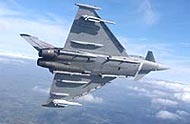The contenders: Eurofighter Typhoon
By Rajiv Singh | 01 Feb 2007
The four-nation (Germany, UK, Italy, Spain) Eurofighter Typhoon is a foreplane delta-wing, beyond-visual-range, close-air fighter aircraft with surface attack capability. It also has super-cruise capability, that is, it can fly at sustained speeds of over Mach 1 without using the afterburner.
The aircraft has been developed by the Eurofighter GmbH consortium, based in Munich and is wholly owned by BAE Systems of the UK, Alenia Aeronautica, subsidiary of Finmeccanica of Italy, EADS Deutschland (formerly a division of DaimlerChrysler) and EADS Spain (formerly CASA). It is powered by a EJ200 engine, developed by Munich-based Eurojet GmbH, which, in turn, is owned by Rolls Royce, MTU Aero Engines, Fiat Aviazione and ITP.
Avionics and systems
The Typhoon is constructed of carbon fibre composites, glass-reinforced plastic, aluminium lithium, titanium and aluminium casting. Its stealth features include low frontal radar cross-section and passive sensors.
Its foreplane/delta configuration is aerodynamically ''unstable'', which provides the aircraft with a high level of agility, including at supersonic speeds, as well as low drag and enhanced lift. The aircraft functions through a computerised digital fly-by-wire system, which provides artificial stabilisation and good control characteristics.
The pilot operates through a Voice-Throttle-and-Stick control system (VTAS). The stick and throttle tops have 24 fingertip controls that operate sensors and weapons, defence aids management, as well as in-flight handling. Direct voice input, in turn, enable the pilot to carry out mode selection and data entry procedures through voice command.
The cockpit has three ''multi-function colour head-down displays'' (MHDDs) which display the tactical situation, systems status and digital maps. A ''helmet mounted symbology'' system, and head up display, display flight reference data, weapon aiming and cueing, and ''forward-looking infrared'' (FLIR) imagery.
A ground proximity navigation and warning system on board this plane uses stored digital elevation data, along with altimeter inputs, to compute the location of the aircraft or a missile above the surface of the earth and to prevent aircraft from flying too close to the ground.
A MIDS low volume terminal provides Link 16 capability for secure transfer of data. Link-16 is a military inter-computer data exchange format of NATO.
The Tranche 2 (second series) versions of the Typhoon will also carry an anti-jam global positioning system.
Countermeasures
The aircraft's ''defensive aids sub-system'' (DASS) provides an all-round prioritised assessment of threats with fully automated response to single or multiple threats. The system includes an electronic countermeasures/support measures system (ECM/ESM), warning against front and rear missile approach, supersonically capable towed decoy systems, laser warning receivers and chaff and flare dispensing system.
The avionics system is based on a data bus with fibre optic highways.
Sensors  The aircraft is equipped with a multi-mode X-band pulse Doppler radar, which has three processing channels. The third channel is used for jammer classification, interference blanking and side lobe ''nulling''.
The aircraft is equipped with a multi-mode X-band pulse Doppler radar, which has three processing channels. The third channel is used for jammer classification, interference blanking and side lobe ''nulling''.
A passive infrared airborne track equipment (PIRATE) on the aircraft is used with the radar as an ''infrared search and track system'' in an air-to-air role, providing passive target detection and tracking. In an air-to-surface role, it performs multiple target acquisition and identification, as well as providing a navigation and landing aid.
Weapons
The Typhoon will carry an internally-mounted Mauser BK27mm gun, which has a linkless-closed ammunition feed system. The Typhoon has 13 hard points for weapons, with four storage points under each wing, and five under the fuselage. Selection, firing and monitoring of weapon status is managed through an armament control system (ACS).
Depending on the mission - be it air-superiority, air interdiction, suppression of enemy air defences (SEAD), multi-role, close air support and maritime attack - the Typhoon can carry a mix of missiles that include beyond visual range, advanced medium range and advanced short-range air-to-air missiles, as well as cruise missiles, anti-radar missiles, GBU-24 Paveway III/IV bombs, anti-armour and anti-ship missiles.
Engine
The Eurofighter is equipped with two Eurojet EJ200 engines, each delivering thrust of 90kN in full reheat and 60kN in dry power mode. The engine features digital control, wide chord aerofoils and single crystal turbine blades along with a convergent /divergent exhaust nozzle and integrated health monitoring.
Perception
Its top class agility, performance, stealth features and advanced avionics mark out the Typhoon as a very capable fighter aircraft. Its cockpit and man/machine interface are of an advanced nature, which is claimed to result in a lower pilot workload.
IAF's MRCA contract
The Typhoon will need to reassure its potential Indian customer in one critical area - transfer of technology. Eurofighter GmbH will need to make its position with respect to transfer of technology very clear. This is one area where Indian susceptibilities would be at their most sensitive.
Indian experts point out that transfer of technology is one area where the Russians, for example, score heavily over their European and American rivals. They are considerably less cagey.